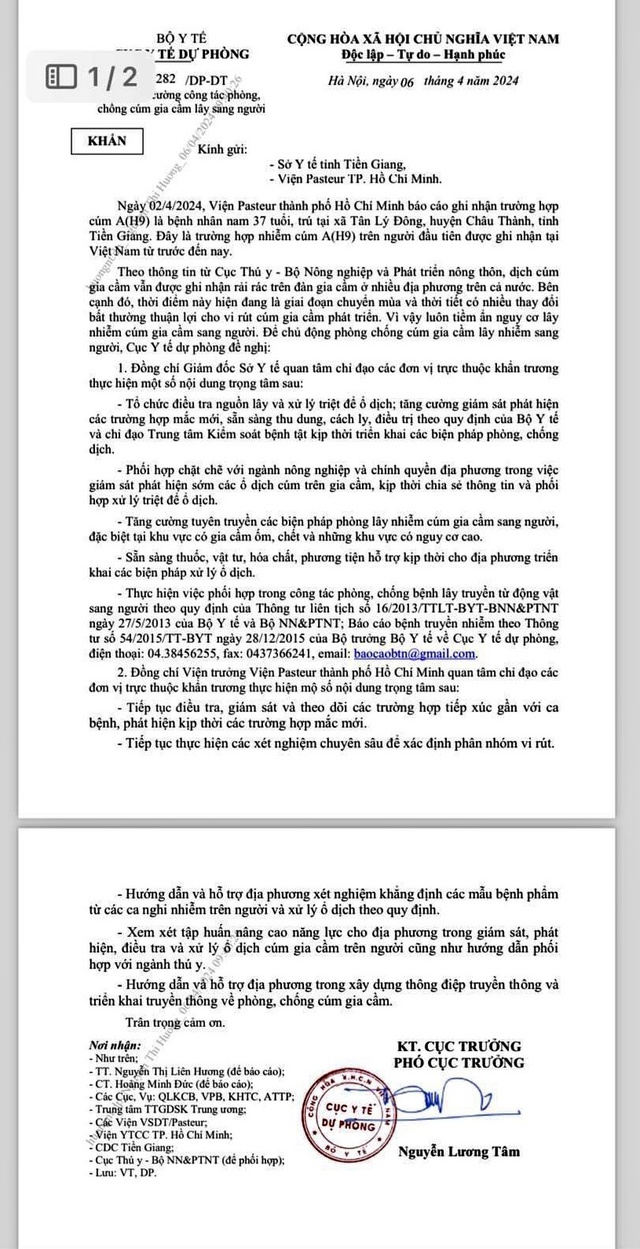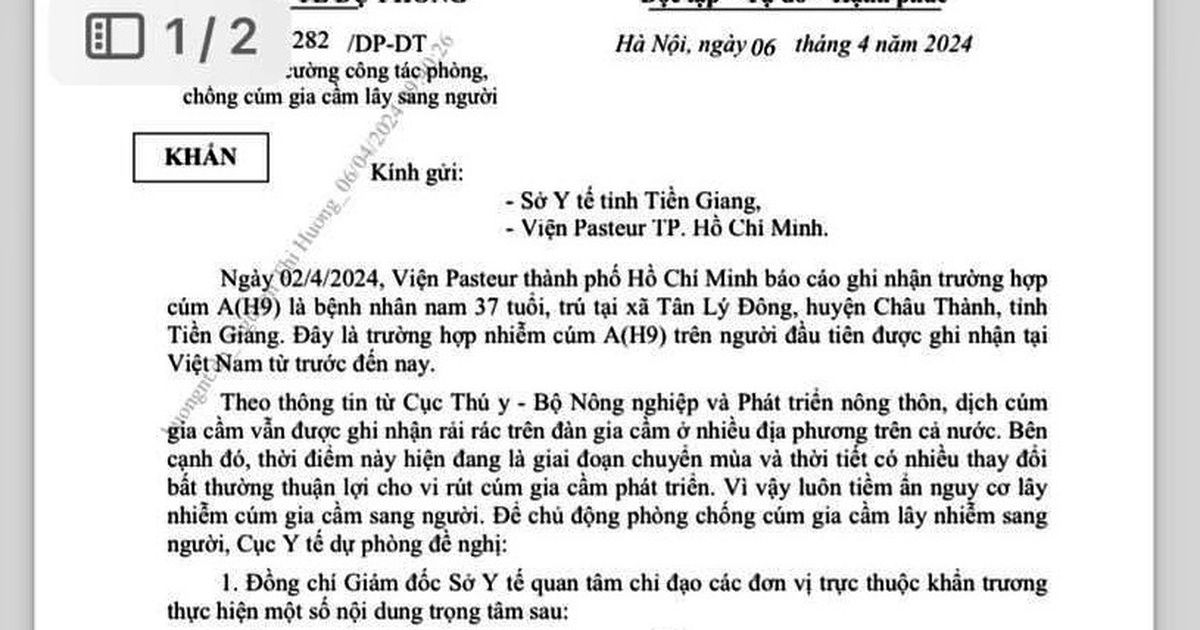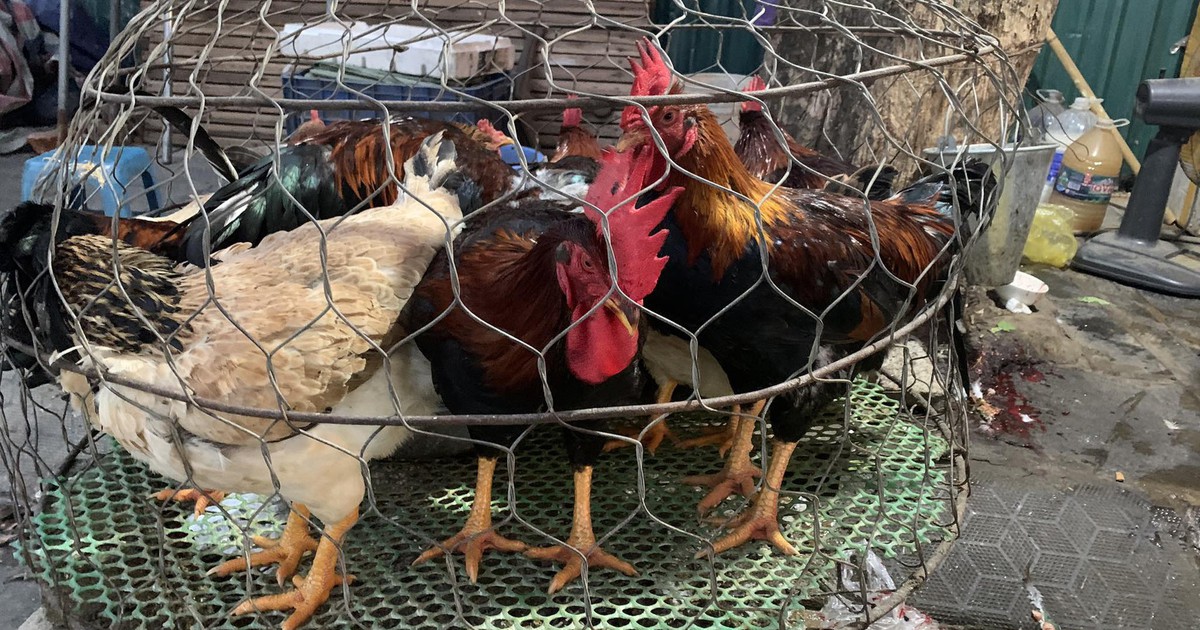Vietnamese Media Reports: Severe A/H9 Case Reported in Tien Giang Province

Credit Wikipedia
#17,993
For the second time in just over 2 weeks Vietnamese state run media is reporting a severe human avian flu infection; this time it is A/(H9) - the first time a human case of this subtype has been reported in that country. While the full subtype has not been determined - unless it is a new reassortment - it is most likely H9N2.
After years of relative quiescence, in recent months we've seen a flurry of avian flu activity in Vietnam - including a fatal H5N1 case reported in late March - and just yesterday, a warning from the FAO on a new H5N1 reassortment in the Mekong Delta region.
Although roughly 130 cases have been reported (see FluTracker's list) over the past 25 years (see ECDC/EFSA graphic below), most have been mild, and the virus is usually detected in children. Nearly 90% of all known cases have been reported by China.

While I haven't found anything posted on the Vietnamese MOH or CDC websites (yet), state run media is widely reporting on the case. First, the following (translated) report from VOV.vn (Voice of Vietnam), after which I'll have a bit more.
Tien Giang conducts emergency treatment after detecting the first case of influenza A/H9
Saturday, 16:21, April 6, 2024

VOV.VN - Information from Pasteur Institute, City. Ho Chi Minh City, just discovered the first case of Influenza A/H9 in the country in Tien Giang province. The health sector, veterinary medicine and local authorities are taking urgent measures to prevent the spread of this disease.
That is patient Nguyen Van D., 37 years old, working as a construction worker, residing in Tan Quoi hamlet, Tan Ly Dong commune, Chau Thanh district (Tien Giang province), currently being treated at the Hospital of Tropical Diseases in Ho Chi Minh City.
Tien Giang Disease Control Center has coordinated with Chau Thanh District Health Center, Tan Ly Dong Commune People's Committee, Epidemiology Department of Region VI Veterinary Department, Livestock and Veterinary Department, Agricultural Service Center Chau Thanh district verified case information, investigated epidemiology and took measures to handle the outbreak in accordance with regulations.
On March 9, the patient had fever, cough with phlegm, abdominal distention, and loss of appetite to be examined at Military Hospital 120 with a diagnosis of liver fibrosis and cirrhosis. The hospital advised the patient to be hospitalized for treatment at the Hospital. City Hospital for Tropical Diseases. HCM and found positive for Influenza AH9. Through verification, this patient 4 weeks ago only lived at home with his wife and did not leave the place of residence; Sometimes I drink alcohol with 2 other people at home. Near the house there is a slaughterhouse and live poultry trading facility.
According to the instructions of the Pasteur Institute of Ho Chi Minh City, the local health sector is handling the epidemic according to the instructions for monitoring and preventing influenza A (H5N1) and influenza A (H7N9); Coordinate with veterinary agencies at all levels to share information about the epidemic situation and coordinate to investigate and handle outbreaks, and take samples for testing on poultry in areas near the patient's home; Perform surface disinfection with Chloramin B 2% in the patient's household and surrounding area; Make a list and monitor daily health of cases who have had close contact with the patient within 14 days from the last contact for adults and 21 days for children under 15 years old.
Instruct close contacts to monitor if they have symptoms such as fever, cough, difficulty breathing, etc. to immediately report to the Health Station. Assign Tan Ly Dong Commune Health Station to monitor and monitor the health of close contacts daily within 14 days from last contact for adults and 21 days for children under 15 years old. During the monitoring period, if there are suspicious symptoms, the Health Station will notify the Tien Giang Center for Disease Control to take samples.
As an LPAI (low path avian influenza) virus, H9N2 is not considered a `reportable' disease by WOAH (formerly the OIE), even though it is zoonotic. We've seen seroprevalence studies which suggest people with exposure to infected poultry often develop H9 antibodies, suggesting mild or asymptomatic infection.
Over the past 15 years we've watched as H9N2 has expanded its geographic range - spreading out of Asia into Europe, the Middle East and Africa. While it occasionally spills over into humans, H9N2's biggest threat may come from its unique ability to reassort with other, potentially more dangerous, avian viruses.

Its internal genes have often been found inside many HPAI viruses (including H5N1, H5N6, H7N9, and most recently zoonotic H3N8) - (see The Lancet's Poultry carrying H9N2 act as incubators for novel human avian influenza viruses).
Reassortment can also occur in humans, and with seasonal flu viruses. The possibility exists that someone could bhttps://afludiary.blogspot.com/2024/04/vietnamese-media-reports-severe-ah9.htmle co-infected with seasonal flu and H9N2, allowing a hybrid (reassortment) to emerge (see The `Other Mixing Vessel' For Pandemic Influenza).

Note quite a month ago, in Infectious Medicine: Rapid Adaptive Substitution of L226Q in HA protein Increases the Pathogenicity of H9N2 Viruses in Mice, we looked at mutations that can enhance the pathogenicity in mammals.
Given unusual severity of today's case, and the FAO Alert issued yesterday on the co-circulation of two clades of H5N1, and the emergence of a new H5N1 genotype in the Mekong Delta Region, we'll be interested to see what - if any - changes may have occurred in this virus.
While LPAI H9N2 ranks pretty far down our pandemic threats list - at least as a standalone virus - it's ability to reassort with potentially more dangerous avian, human, and swine flu viruses make any uptick in cases worthy of our attention.

Credit Wikipedia
#17,993
For the second time in just over 2 weeks Vietnamese state run media is reporting a severe human avian flu infection; this time it is A/(H9) - the first time a human case of this subtype has been reported in that country. While the full subtype has not been determined - unless it is a new reassortment - it is most likely H9N2.
After years of relative quiescence, in recent months we've seen a flurry of avian flu activity in Vietnam - including a fatal H5N1 case reported in late March - and just yesterday, a warning from the FAO on a new H5N1 reassortment in the Mekong Delta region.
Although roughly 130 cases have been reported (see FluTracker's list) over the past 25 years (see ECDC/EFSA graphic below), most have been mild, and the virus is usually detected in children. Nearly 90% of all known cases have been reported by China.

While I haven't found anything posted on the Vietnamese MOH or CDC websites (yet), state run media is widely reporting on the case. First, the following (translated) report from VOV.vn (Voice of Vietnam), after which I'll have a bit more.
Tien Giang conducts emergency treatment after detecting the first case of influenza A/H9
Saturday, 16:21, April 6, 2024

VOV.VN - Information from Pasteur Institute, City. Ho Chi Minh City, just discovered the first case of Influenza A/H9 in the country in Tien Giang province. The health sector, veterinary medicine and local authorities are taking urgent measures to prevent the spread of this disease.
That is patient Nguyen Van D., 37 years old, working as a construction worker, residing in Tan Quoi hamlet, Tan Ly Dong commune, Chau Thanh district (Tien Giang province), currently being treated at the Hospital of Tropical Diseases in Ho Chi Minh City.
Tien Giang Disease Control Center has coordinated with Chau Thanh District Health Center, Tan Ly Dong Commune People's Committee, Epidemiology Department of Region VI Veterinary Department, Livestock and Veterinary Department, Agricultural Service Center Chau Thanh district verified case information, investigated epidemiology and took measures to handle the outbreak in accordance with regulations.
On March 9, the patient had fever, cough with phlegm, abdominal distention, and loss of appetite to be examined at Military Hospital 120 with a diagnosis of liver fibrosis and cirrhosis. The hospital advised the patient to be hospitalized for treatment at the Hospital. City Hospital for Tropical Diseases. HCM and found positive for Influenza AH9. Through verification, this patient 4 weeks ago only lived at home with his wife and did not leave the place of residence; Sometimes I drink alcohol with 2 other people at home. Near the house there is a slaughterhouse and live poultry trading facility.
According to the instructions of the Pasteur Institute of Ho Chi Minh City, the local health sector is handling the epidemic according to the instructions for monitoring and preventing influenza A (H5N1) and influenza A (H7N9); Coordinate with veterinary agencies at all levels to share information about the epidemic situation and coordinate to investigate and handle outbreaks, and take samples for testing on poultry in areas near the patient's home; Perform surface disinfection with Chloramin B 2% in the patient's household and surrounding area; Make a list and monitor daily health of cases who have had close contact with the patient within 14 days from the last contact for adults and 21 days for children under 15 years old.
Instruct close contacts to monitor if they have symptoms such as fever, cough, difficulty breathing, etc. to immediately report to the Health Station. Assign Tan Ly Dong Commune Health Station to monitor and monitor the health of close contacts daily within 14 days from last contact for adults and 21 days for children under 15 years old. During the monitoring period, if there are suspicious symptoms, the Health Station will notify the Tien Giang Center for Disease Control to take samples.
As an LPAI (low path avian influenza) virus, H9N2 is not considered a `reportable' disease by WOAH (formerly the OIE), even though it is zoonotic. We've seen seroprevalence studies which suggest people with exposure to infected poultry often develop H9 antibodies, suggesting mild or asymptomatic infection.
Over the past 15 years we've watched as H9N2 has expanded its geographic range - spreading out of Asia into Europe, the Middle East and Africa. While it occasionally spills over into humans, H9N2's biggest threat may come from its unique ability to reassort with other, potentially more dangerous, avian viruses.

Its internal genes have often been found inside many HPAI viruses (including H5N1, H5N6, H7N9, and most recently zoonotic H3N8) - (see The Lancet's Poultry carrying H9N2 act as incubators for novel human avian influenza viruses).
Reassortment can also occur in humans, and with seasonal flu viruses. The possibility exists that someone could bhttps://afludiary.blogspot.com/2024/04/vietnamese-media-reports-severe-ah9.htmle co-infected with seasonal flu and H9N2, allowing a hybrid (reassortment) to emerge (see The `Other Mixing Vessel' For Pandemic Influenza).

Note quite a month ago, in Infectious Medicine: Rapid Adaptive Substitution of L226Q in HA protein Increases the Pathogenicity of H9N2 Viruses in Mice, we looked at mutations that can enhance the pathogenicity in mammals.
Given unusual severity of today's case, and the FAO Alert issued yesterday on the co-circulation of two clades of H5N1, and the emergence of a new H5N1 genotype in the Mekong Delta Region, we'll be interested to see what - if any - changes may have occurred in this virus.
While LPAI H9N2 ranks pretty far down our pandemic threats list - at least as a standalone virus - it's ability to reassort with potentially more dangerous avian, human, and swine flu viruses make any uptick in cases worthy of our attention.











Comment